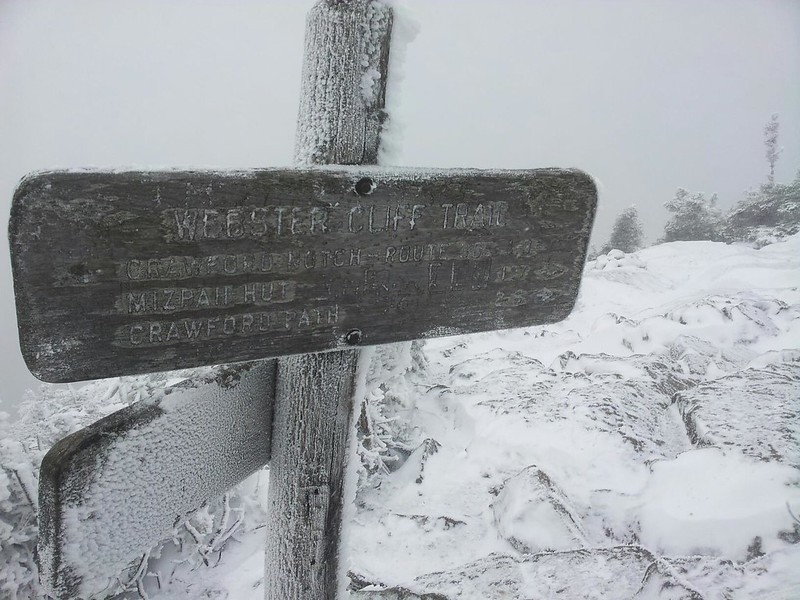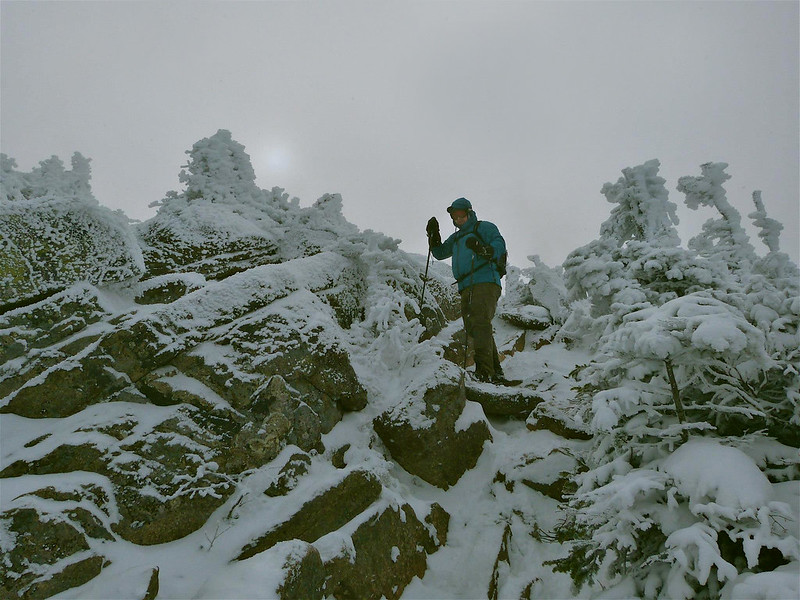antelucyferum
New member
- Joined
- Oct 25, 2012
- Messages
- 2
- Reaction score
- 0
Trail conditions: Complete snow cover on trail after fork to Mts. Jackson and Webster. Not icy until last 100 feet. Slippery rocks throughout, and very wet before snow cover starts.
Weather conditions: Just around freezing temperatures. Very low winds until the last 100 feet, at which point high winds.
Special gear needed: Reliably waterproof boots. Crampons soon but not yet, for the summit cone.
Having started on my 48 patch in September, I didn't want wintry conditions to stop me from bagging at least a few more 4,000-footers by the end of the year. My companions and I chose Mt. Jackson to ease into winter hiking. We hit the Webster-Jackson trail yesterday at 10:15 and did the 5.2 mile rount-trip in five hours, including stops to snack, chat with other hikers, thaw our water, and gawk at the beauty. By 15:15, the parking lot was nearly empty, though it had started out completely full.
Even before the spur to Elephant Head, the snow cover was complete. Trees were weighed down with snow that was wetter than the fluff falling on us most of the day. Even the blue blazes were entirely obscured by earlier southwest-driving snow. But the trail was still dirt, leaves, and mud, which made for a gentle warm-up. There was no ice until the ledges at the summit cone, and the only slippery footing was stream crossing and well-polished roots that made for good handles up scrambly bits. I was never more grateful for good waterproofing on my boots, though. Some of the mud was much deeper than it appeared.
Somewhere after the turnoff to the Bugle Cliff view, we took a wrong turn. The trail swings left and up, but it was difficult to discern. To the right there appeared to be a much clearer trail. We turned around quickly when the it got too narrow with rocks and logs, so I still don't know where that was supposed to lead.
We saw the first Gray Jays at about 1.4 miles, where the trail forks to Mt. Webster. They were bold as ever. Aggressive, even! We stopped for lunch, which was of debatable value. We cooled down quickly, and it's not so long a hike that snacks aren't essential. Perhaps better to keep going. Still, it was fun to shoo away the jays from my tin of peanut butter blended with coconut milk, dried coconut, and flax seed meal. Too bad, Jay: It's perfect trail fuel and I'm not sharing.
At that main turnoff we started encountering more hikers, too, and I was encouraged to see only one set of crampon tracks. Perhaps the icy ledges wouldn't be so bad. It was interesting to hear how different groups described the top: "It's a bit gusty." "It's extremely windy up there!" In the last 500 feet or so, we started hearing the wind, making us promises of a cold and hasty summiting. Until that point, the hike had been still and quiet, with all the normal background forest sounds muffled by the snow. One of the more delightful aspects of winter in the woods.
By about the last 100 feet, the snow was 6" deep. Surrounded by that much winter -- now a white forest trimmed in green -- I didn't miss the views at all. Besides, the winds at the top were at least 45mph. I wasn't about to stick around, view or none. Even the trees looked more put-upon than usual on an exposed Presidentials summit. They looked like short snowmen hunched into the wind, believing in a summit they'd never quite reach.
It was difficult to see with the wind blowing icy flecks into my face, but it was clear enough to slide buttwise down some of the ledges. Thereafter, the descent was easy, making for an overall moderate winter hike. Lovely for beginners, I'd think, with the caveat that you can't count on seeing blazes and instead must be very confident in following the trail maps. With such a glorious experience, I'll have to be careful not to get lazy and assume all that wintry hikes are so simple.
Weather conditions: Just around freezing temperatures. Very low winds until the last 100 feet, at which point high winds.
Special gear needed: Reliably waterproof boots. Crampons soon but not yet, for the summit cone.
Having started on my 48 patch in September, I didn't want wintry conditions to stop me from bagging at least a few more 4,000-footers by the end of the year. My companions and I chose Mt. Jackson to ease into winter hiking. We hit the Webster-Jackson trail yesterday at 10:15 and did the 5.2 mile rount-trip in five hours, including stops to snack, chat with other hikers, thaw our water, and gawk at the beauty. By 15:15, the parking lot was nearly empty, though it had started out completely full.
Even before the spur to Elephant Head, the snow cover was complete. Trees were weighed down with snow that was wetter than the fluff falling on us most of the day. Even the blue blazes were entirely obscured by earlier southwest-driving snow. But the trail was still dirt, leaves, and mud, which made for a gentle warm-up. There was no ice until the ledges at the summit cone, and the only slippery footing was stream crossing and well-polished roots that made for good handles up scrambly bits. I was never more grateful for good waterproofing on my boots, though. Some of the mud was much deeper than it appeared.
Somewhere after the turnoff to the Bugle Cliff view, we took a wrong turn. The trail swings left and up, but it was difficult to discern. To the right there appeared to be a much clearer trail. We turned around quickly when the it got too narrow with rocks and logs, so I still don't know where that was supposed to lead.
We saw the first Gray Jays at about 1.4 miles, where the trail forks to Mt. Webster. They were bold as ever. Aggressive, even! We stopped for lunch, which was of debatable value. We cooled down quickly, and it's not so long a hike that snacks aren't essential. Perhaps better to keep going. Still, it was fun to shoo away the jays from my tin of peanut butter blended with coconut milk, dried coconut, and flax seed meal. Too bad, Jay: It's perfect trail fuel and I'm not sharing.
At that main turnoff we started encountering more hikers, too, and I was encouraged to see only one set of crampon tracks. Perhaps the icy ledges wouldn't be so bad. It was interesting to hear how different groups described the top: "It's a bit gusty." "It's extremely windy up there!" In the last 500 feet or so, we started hearing the wind, making us promises of a cold and hasty summiting. Until that point, the hike had been still and quiet, with all the normal background forest sounds muffled by the snow. One of the more delightful aspects of winter in the woods.
By about the last 100 feet, the snow was 6" deep. Surrounded by that much winter -- now a white forest trimmed in green -- I didn't miss the views at all. Besides, the winds at the top were at least 45mph. I wasn't about to stick around, view or none. Even the trees looked more put-upon than usual on an exposed Presidentials summit. They looked like short snowmen hunched into the wind, believing in a summit they'd never quite reach.
It was difficult to see with the wind blowing icy flecks into my face, but it was clear enough to slide buttwise down some of the ledges. Thereafter, the descent was easy, making for an overall moderate winter hike. Lovely for beginners, I'd think, with the caveat that you can't count on seeing blazes and instead must be very confident in following the trail maps. With such a glorious experience, I'll have to be careful not to get lazy and assume all that wintry hikes are so simple.
Last edited:










![Yellowstone National Park [Map Pack Bundle] (National Geographic Trails Illustrated Map)](https://m.media-amazon.com/images/I/51kGuJ72qjL._SL500_.jpg)
























![Grand Teton Day Hikes and National Park Map [Map Pack Bundle] (National Geographic Trails Illustrated Map)](https://m.media-amazon.com/images/I/41DB0jvRnbL._SL500_.jpg)

























![Grand Canyon, North and South Rims [Grand Canyon National Park] (National Geographic Trails Illustrated Map)](https://m.media-amazon.com/images/I/419Y-ycyVUL._SL500_.jpg)




